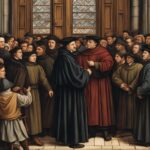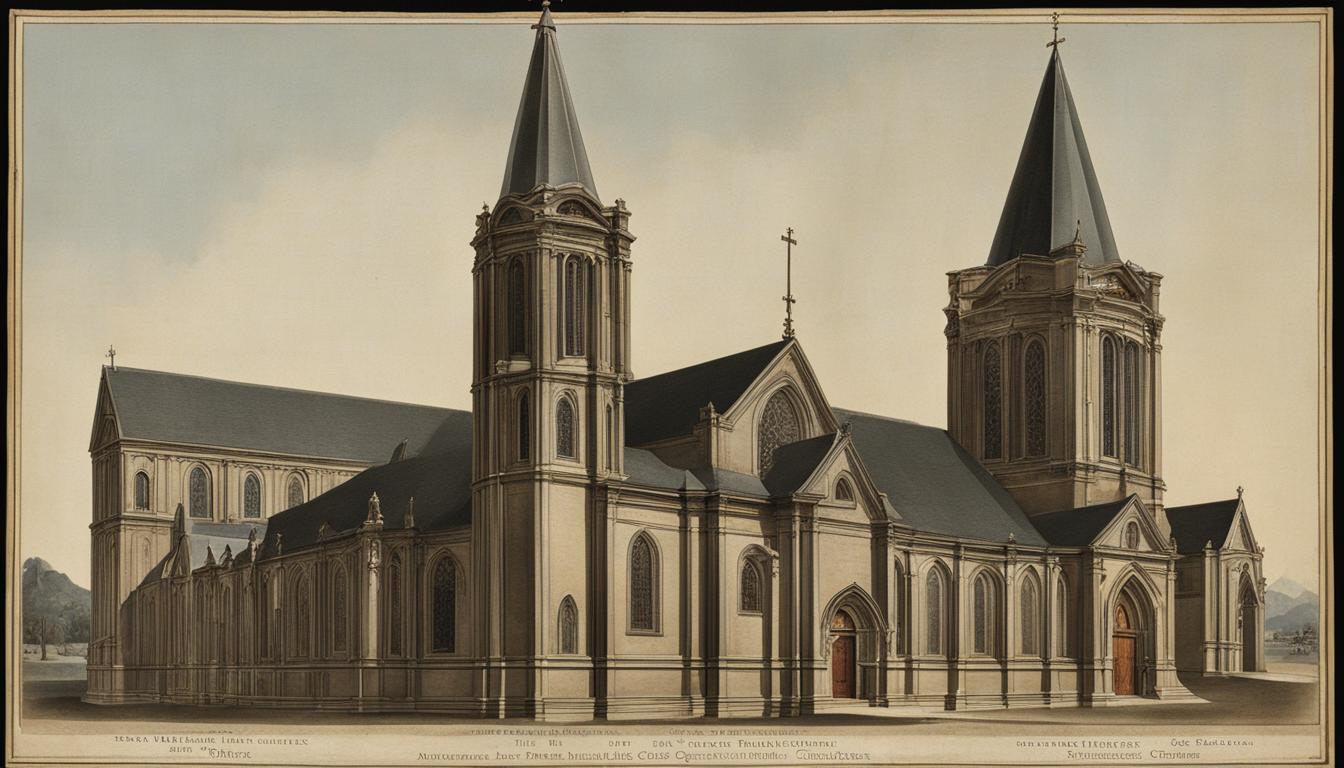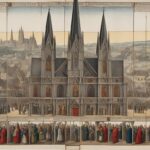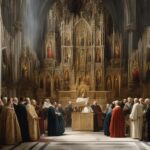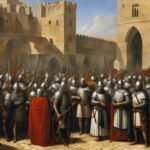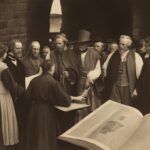During the 16th century, a religious movement known as the Reformation swept through Europe, causing a significant upheaval in both religious and political spheres. Led by prominent figures such as Martin Luther, the Reformation challenged the authority of the Catholic Church and sparked widespread reforms. This period of religious turmoil and transformation left an indelible mark on European society, shaping the course of history for centuries to come.
Key Takeaways:
- The Reformation was a religious movement that took place in 16th-century Europe.
- Martin Luther and other reformers challenged the authority of the Catholic Church and advocated for church reforms.
- The Reformation had a profound impact on European history, leading to religious upheaval, wars, and the emergence of Protestantism.
- The printing press played a crucial role in spreading Reformation ideas and facilitating the dissemination of reformers’ works.
- The Reformation’s legacy can be seen in the enduring influence of Protestantism, the emphasis on individual faith and the Bible, and the cultural achievements inspired by the movement.
The Origins of the Reformation
The Protestant Reformation can be traced back to the 1517 publication of Martin Luther’s “95 Theses,” in which he criticized the Catholic Church’s practice of selling indulgences. Luther’s ideas gained popularity due to the widespread use of the printing press, which allowed for the dissemination of his works. His emphasis on the Bible as the sole source of spiritual authority and the need for church reform sparked the Reformation.
Throughout Europe, Martin Luther’s bold actions and writings ignited a significant movement that challenged the authority of the Catholic Church. His 95 Theses, initially intended for theological debate, became a catalyst for change. Luther’s criticisms of indulgences struck a chord with many, as people began questioning the legitimacy of paying for forgiveness. The widespread use of the printing press enabled Luther’s ideas to reach a broader audience, fanning the flames of discontent with the Catholic Church.
The printing press played a crucial role in the Reformation, allowing Luther’s writings to be reproduced and distributed far and wide. This technology revolutionized the dissemination of information, making it easier for reformers like Luther to challenge established authority. The ability to mass-produce pamphlets and books meant that ideas could be shared quickly and efficiently, helping to spread the principles of the Reformation throughout Europe.
The printing press is the greatest weapon in the armory of the Reformation. – Martin Luther
The impact of Luther’s ideas and the printing press cannot be overstated. The Reformation was a direct result of these two intertwined forces. It marked a turning point in European history and laid the foundation for the emergence of Protestantism as a distinct religious movement.
Martin Luther’s 95 Theses
| Thesis Number | Summary |
|---|---|
| 1 | Indulgences are not necessary for salvation. |
| 27 | Indulgences cannot remove guilt or penalties imposed by God. |
| 32 | The treasury of the Church is not limitless. |
| 62 | The true treasure of the Church is the Gospel. |
| 95 | Christians should focus on repentance and inner spiritual growth rather than relying on indulgences. |
Martin Luther and Lutheranism
Martin Luther, a key figure in the Protestant Reformation, played a significant role in shaping the religious landscape of Germany and beyond. Born in 1483, Luther became an Augustinian monk and later a university lecturer in Wittenberg. It was here that he would launch his powerful challenge to the Catholic Church, sparking a religious revolution that would have far-reaching consequences.
One of Luther’s most important contributions was the translation of the Bible into German, making it accessible to the common people. This broke with the tradition of Latin being the exclusive language of the Church, empowering individuals to read and interpret the scripture for themselves. Luther’s emphasis on the authority of the Bible as the sole source of spiritual truth laid the foundation for the development of Lutheranism, a distinct form of Protestantism.
Central to Luther’s teachings was the concept of the “priesthood of all believers,” which emphasized the direct relationship between individuals and God. Luther believed that all Christians had the ability to interpret Scripture and had equal access to God’s grace, challenging the hierarchical structure of the Catholic Church. These ideas resonated with many Germans and Lutheranism quickly spread throughout the country, becoming the state religion in several regions.
Luther’s translation of the Bible and his theological innovations had a profound impact on the development of Protestant beliefs and practices. Today, Lutheranism remains one of the largest Christian denominations in the world, with millions of followers worldwide. The legacy of Martin Luther and his role in the Reformation continue to be studied and celebrated, marking a significant turning point in Christian history.
The Swiss Reformation and Calvinism
The Swiss Reformation, which began in the early 16th century, played a vital role in shaping the Protestant movement. Ulrich Zwingli, a Swiss theologian and priest, preached reformist ideas in Zurich, challenging the authority of the Catholic Church. Zwingli’s teachings aligned closely with those of Martin Luther, emphasizing the primacy of scripture and rejecting practices such as indulgences. However, it was John Calvin, a French theologian, who would leave a lasting impact on the Swiss Reformation with his development of Calvinism.
Calvinism, also known as Reformed theology, was based on Calvin’s teachings and gained traction not only in Switzerland but also throughout Europe. Central to Calvinism was the doctrine of predestination, which held that God had already determined the salvation or damnation of individuals before their birth. Calvin also emphasized the absolute sovereignty of God and the necessity of a strict moral code in the Christian life.
“God preordains everything, the good and the evil. Yet He is not the author of evil; for the evil is contrary to His will.”
Calvin’s teachings brought about significant changes in religious practice. In Geneva, where Calvin settled, the church was restructured, and new regulations were introduced to govern the city’s moral behavior. The implementation of Calvinist principles led to a strict and disciplined society, with a focus on education, work ethic, and community responsibility. Calvinism also influenced the development of Presbyterianism in Scotland and other Reformed churches throughout Europe.
The Spread of Calvinism
The influence of Calvinism extended far beyond Switzerland. The theology found receptive audiences in France, the Netherlands, Scotland, and even in the American colonies. Dutch Calvinism, in particular, had a profound impact on religious and economic life in the Netherlands, contributing to the country’s rise as a major European power during the Golden Age.
Calvin’s writings, particularly his magnum opus “Institutes of the Christian Religion,” became foundational texts for the Reformed tradition. His emphasis on the authority of scripture, the sovereignty of God, and the importance of personal piety continue to shape the beliefs and practices of millions of Christians worldwide.
| Key Beliefs of Calvinism | Key Reformed Denominations |
|---|---|
|
|

The English Reformation
The English Reformation was a significant religious and political transformation in England during the 16th century. It was driven by the actions of King Henry VIII and resulted in the establishment of the Church of England as a separate institution from the Roman Catholic Church.
Henry VIII’s desire to annul his marriage to Catherine of Aragon, in order to secure a male heir, put him at odds with the Catholic Church, which refused to grant the annulment. In response, Henry VIII broke away from Rome and declared himself the head of the Church of England, effectively severing ties with Catholicism.
This shift towards Protestantism was further solidified during the reigns of Edward VI and Elizabeth I. Edward VI promoted Protestant reforms, while Elizabeth I sought a middle ground between Catholicism and Calvinism. The Church of England, or Anglican Church, became the established religion in England.
“The Reformation and the establishment of the Church of England represented a significant break from the authority of the Pope and the traditions of the Roman Catholic Church in England.” – Scholar
The Impact of the English Reformation
The English Reformation had far-reaching consequences, both religiously and politically. It had a profound impact on England’s society and culture, as well as its relationship with other European nations.
- The dissolution of monasteries and confiscation of church lands under Henry VIII’s reign led to significant social and economic changes.
- The distribution of the English Bible, promoted by the Protestant leaders, increased literacy rates and shaped the English language.
- Religious conflicts and tensions persisted throughout the following decades, including periods of persecution against Catholics and Protestants.
- The Church of England became a dominant force and a symbol of national identity, with its own distinct theology and practices.
The English Reformation set the stage for future religious developments in England and influenced the growth of Protestantism in other parts of the world. Its impact continues to be felt in the religious and cultural landscape of England and beyond.
| Impact of the English Reformation | Catholicism | Protestantism |
|---|---|---|
| Authority | Supreme authority of the Pope | Moved away from papal authority, with the monarch as the head of the Church |
| Language | Latin in religious services | Introduction of English in church services, facilitating greater understanding and participation |
| Monasticism | Monasteries played a significant role in religious life | Dissolution of monasteries and confiscation of their assets |
| Spirituality | Emphasis on sacraments, saints, and intercessory prayer | Focus on the Bible, individual faith, and direct connection with God |
| Religious Practices | Traditional liturgy, rituals, and traditions | Introduction of English liturgy and removal of some Catholic practices |
The Counter-Reformation
The Counter-Reformation was a significant response by the Catholic Church to the challenges posed by the Protestant Reformation. It aimed to address the issues raised by the reformers, strengthen the teachings of the Catholic Church, and combat the spread of Protestantism. The Counter-Reformation had a profound impact on the spiritual, social, and political aspects of Europe during the 16th century.
The Council of Trent, held from 1545 to 1563, was a key event in the Counter-Reformation. It was a series of meetings where Catholic leaders convened to discuss and address the reforms demanded by the Protestants. The Council reaffirmed traditional Catholic teachings and established new spiritual reforms, such as improving the education and behavior of the clergy. It also standardized liturgical practices and the administration of the sacraments.
The Inquisition, an institution established by the Catholic Church to combat heresy, was also reformed during this period. The Spanish Inquisition, in particular, gained notoriety for its methods of interrogation and punishment. The Counter-Reformation provided a fertile ground for the establishment of new religious orders, such as the Society of Jesus, or Jesuits, who played an essential role in spreading Catholic teachings and defending the faith.
The Impact of the Counter-Reformation
The Counter-Reformation had a lasting impact on the Catholic Church and Europe as a whole. It revitalized the Catholic faith and inspired a renewed sense of spiritual fervor among believers. The Council of Trent’s reforms strengthened the Catholic Church’s teachings and practices, which helped to solidify its position as the dominant religious institution in Europe. The Inquisitions, though controversial, played a crucial role in maintaining Catholic orthodoxy and combating the spread of Protestant ideas.
The Counter-Reformation also had significant social and political implications. The religious tensions between Catholics and Protestants led to conflicts and wars in various parts of Europe, with the Thirty Years’ War being one of the most devastating. The Counter-Reformation also influenced art and culture, with artists like Caravaggio and Bernini creating works that aimed to evoke strong emotions and convey the power of the Catholic faith.
A Table Demonstrating the Impact of the Counter-Reformation
| Aspect | Impact |
|---|---|
| Spiritual Reforms | Strengthening of Catholic teachings, improvements in the education and behavior of the clergy, standardization of liturgical practices and sacraments |
| Inquisitions | Combatting heresy, maintaining Catholic orthodoxy, suppressing dissent |
| Religious Orders | Establishment of new orders like the Jesuits, spreading Catholic teachings and defending the faith |
| Social and Political Impact | Conflicts, wars, and tensions between Catholics and Protestants, the dominance of the Catholic Church in Europe, influence on art and culture |
Overall, the Counter-Reformation was a significant response by the Catholic Church to the challenges posed by the Protestant Reformation. It resulted in reforms, renewed spiritual fervor, and had wide-ranging social and political implications. The impact of the Counter-Reformation continues to shape the Catholic Church and European history to this day.
Political and Social Impact of the Reformation
The Reformation had far-reaching political and social consequences that shaped the course of history. The emergence of Protestantism brought about significant political changes, with religious freedoms becoming a central focus. In the wake of the Reformation, various religious movements and sects flourished, challenging the traditional authority of the Catholic Church.
One of the most significant outcomes of the Reformation was the eruption of wars throughout Europe. The Thirty Years’ War, lasting from 1618 to 1648, stands as one of the deadliest conflicts in history. Fueled by political and religious tensions, this war resulted in the loss of millions of lives and widespread destruction. The war had a lasting impact on Germany, leaving the region devastated and reshaping the balance of power in Europe.
Amidst the turmoil, the Reformation also paved the way for intellectual and cultural flourishing. As Protestantism spread, the emphasis on individual interpretation of the Bible fostered a spirit of intellectual inquiry and innovation. The development of universities and the rise of Protestant denominations inspired a diverse range of thinkers and artists, leading to remarkable advancements in literature, music, and art. The cultural achievements of the Reformation period continue to influence our society today.

| Political Changes | Religious Freedoms | Wars | Intellectual and Cultural Flourishing |
|---|---|---|---|
| The Reformation challenged the authority of traditional political institutions, leading to the rise of new forms of governance and the redistribution of power. | Protestantism advocated for religious freedoms and the right to interpret the Bible independently, allowing individuals to practice their faith outside of the Catholic Church. | The Reformation sparked numerous conflicts and wars, including the Thirty Years’ War, as both Protestant and Catholic forces vied for dominance. | The Reformation stimulated intellectual and cultural growth, inspiring new artistic movements, scientific discoveries, and literary achievements. |
Pre-Reformation Schism and Early Criticisms
The roots of the Protestant Reformation can be traced back to the pre-Reformation schism within Christianity, known as the East-West Schism in 1054. This division split Christianity into the Roman Catholic Church in the West and the Eastern Orthodox Church in the East. The East-West Schism highlighted the growing theological and cultural differences between the two branches of Christianity and set the stage for the criticisms that would later fuel the Reformation.
During this time, there were early criticisms of the Roman Catholic Church and its practices. One of the main points of contention was the sale of indulgences, which were certificates sold by the Church that promised the remission of sins. Critics argued that such practices were exploitative and undermined the true meaning of faith and salvation. These early criticisms planted the seeds of discontent and paved the way for the Reformation’s focus on challenging the authority and teachings of the Catholic Church.
“The indulgences which the preachers cry as the ‘greatest graces’ are in fact truly such only when they promote financial gain.” – Martin Luther
Martin Luther’s Ninety-Five Theses, published in 1517, specifically targeted the sale of indulgences and sparked a wave of reformist ideas throughout Europe. Luther’s criticisms resonated with many who were dissatisfied with the state of the Church and its practices. The Reformation would go on to address not only the issue of indulgences but also broader theological beliefs, church governance, and the role of the Bible in spiritual matters.
The Early Criticisms of the Roman Catholic Church:
- Opposition to the sale of indulgences
- Concerns about corruption within the Church
- Desire for a more direct relationship with God
- Calls for the translation of the Bible into vernacular languages
The early criticisms of the Roman Catholic Church laid the groundwork for the Reformation, as they challenged the prevailing religious and institutional norms of the time. These criticisms would continue to evolve and gain momentum, ultimately leading to the significant religious, political, and cultural changes brought about by the Protestant Reformation.

Spread of Reformation Ideas
The invention of the printing press revolutionized the spread of ideas during the Reformation. Martin Luther, a key figure in the movement, effectively utilized this new technology to disseminate his works and theological insights. His writings, including his famous “95 Theses,” were widely printed and circulated, reaching a broad audience across Europe. The accessibility of printed materials allowed Luther’s ideas to gain traction and sparked a wave of religious reform.
The impact of the printing press extended beyond Luther’s works. William Tyndale’s English translation of the Bible played a crucial role in spreading Protestant teachings. Tyndale’s translation allowed ordinary people to read and understand the Bible in their vernacular language, empowering them to engage with and interpret Scripture directly. This access to the English Bible further fueled the growth of Protestantism in England and beyond.
“The printing press is the greatest weapon in the armory of the Reformation.”
– Martin Luther
The printing press not only facilitated the spread of Reformation ideas but also empowered individuals to think critically and question the established religious authority. The availability of printed materials challenged the monopoly of knowledge previously held by the Catholic Church and opened up new avenues for intellectual exploration and religious expression.
| Advancements | Impact |
|---|---|
| Printing press | Revolutionized communication, allowed for mass production of books and pamphlets. |
| Martin Luther’s writings | Spread Reformation ideas, incited religious reform. |
| William Tyndale’s English translation of the Bible | Enabled wider access to Scripture, contributed to the growth of Protestantism. |
| Increased literacy | Empowered individuals to engage with religious texts and interpret them for themselves. |
The printing press played a pivotal role in the Reformation, shaping the dissemination of ideas and challenging the established religious order. Its impact on the spread of Protestantism and the accessibility of religious texts transformed the religious landscape of Europe and laid the groundwork for intellectual and religious freedom.

Reformation in England
The Reformation in England was a significant turning point in the country’s religious history. It was primarily driven by the actions of King Henry VIII, who sought an annulment of his marriage to Catherine of Aragon due to her failure to produce a male heir.
When the Pope refused to grant the annulment, Henry VIII took matters into his own hands and established the Church of England in 1534. This new church, also known as the Anglican Church, was intended to be a middle ground between Roman Catholicism and Protestantism. While it retained many Catholic traditions and practices, it rejected the authority of the Pope.
The Reformation in England continued under the reign of Henry’s son, Edward VI, who promoted Protestantism and implemented further reforms within the Church. However, these changes were short-lived, as Edward died at a young age, leading to a period of religious turbulence under the Catholic rule of Mary I. She attempted to restore Catholicism as the official religion, leading to the persecution of Protestants.
It was during the reign of Elizabeth I, Henry VIII’s daughter, that the Church of England found its definitive form. Elizabeth sought a “middle way” between Catholicism and Calvinism, establishing the Church of England as a distinct Protestant denomination. This marked the consolidation of the English Reformation and the establishment of a church that remains influential in British society today.
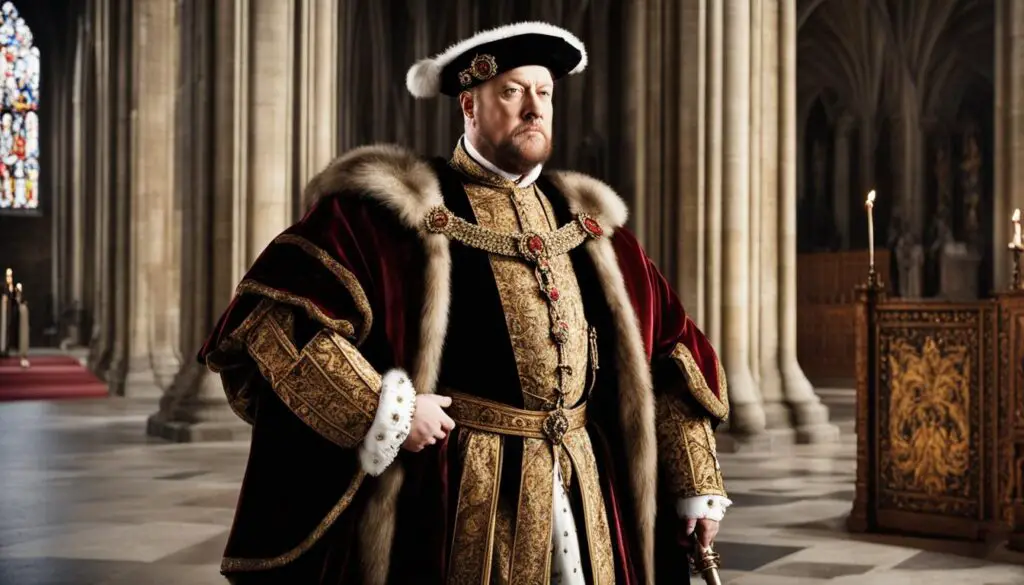
The Reformation in England: A Timeline
| Event | Date |
|---|---|
| Henry VIII’s break from the Catholic Church | 1534 |
| Establishment of the Church of England | 1534 |
| Edward VI promotes Protestantism | 1547-1553 |
| Mary I attempts to restore Catholicism | 1553-1558 |
| Elizabeth I establishes the Church of England | 1558-1603 |
Reformation in America
The Reformation had a profound impact not only on Europe but also on the religious landscape of America. One group that was heavily influenced by the Reformation were the Puritans. The Puritans were English Protestants who sought to reform the Church of England. They believed that the church needed to further purify its practices and teachings. The Puritans wanted a simpler, more stripped-down form of worship that was centered around the Bible. In search of religious freedom and the opportunity to practice their beliefs, some Puritans became Separatists and eventually settled in Plymouth, Massachusetts, in 1620, known as the Pilgrims.
The Separatists, or Pilgrims, sought religious freedom and a community where they could practice their faith without persecution. They believed in the importance of individual religious experience and the separation of church and state. The Pilgrims played a significant role in the establishment of the Plymouth Colony and the development of a tradition of religious freedom in America.
Another group influenced by the Reformation were the non-separatist Puritans, who established the Massachusetts Bay Colony in 1630. The Puritans aimed to create a society based on their religious beliefs, which included strict moral codes and a focus on communal living. They believed that their community should serve as a “city upon a hill,” a shining example of piety and righteousness for the world to see.
Table: Puritans vs. Pilgrims
| Aspect | Puritans | Pilgrims |
|---|---|---|
| Beliefs | Church reform, strict moral codes | Individual religious experience, separation of church and state |
| Settlement | Massachusetts Bay Colony | Plymouth Colony |
| Religious Freedom | Seeking to establish their own religious community | Seeking religious freedom and escape from persecution |
The Reformation, with its emphasis on church reform and religious freedom, played a significant role in shaping the early American colonies. The ideas and beliefs of the Puritans and the Pilgrims laid the foundation for the development of a diverse religious landscape in America, where individuals were free to practice their faith and establish their own communities based on their religious beliefs.
Conclusion
The Reformation was a pivotal period in European history that had a profound impact on religious, political, and cultural aspects of society. This religious movement, led by reformers like Martin Luther, challenged the authority of the Catholic Church and advocated for change. The Reformation sparked a wave of religious and political freedoms in Northern Europe, but also resulted in conflicts and wars.
The legacy of the Reformation is still evident today, with the establishment of various Protestant denominations and the emphasis on individual faith and the Bible. The Reformation also played a significant role in shaping European and American society, inspiring cultural achievements and influencing the development of religious thought in the New World.
The impact of the Reformation cannot be understated. It reshaped Europe’s religious landscape, introduced new ideas and beliefs, and set the stage for further religious and political transformations. The Reformation’s influence continues to shape our world, reminding us of the power of individual faith and the enduring legacy of this historic movement.
FAQ
What was the Protestant Reformation?
The Protestant Reformation was a 16th-century religious, political, intellectual, and cultural movement in Europe that challenged the authority of the Catholic Church and led to the formation of new Protestant denominations.
Who were the key leaders of the Reformation?
Martin Luther, John Calvin, and Henry VIII were influential figures in the Protestant Reformation.
What sparked the Reformation?
The Reformation was sparked by Martin Luther’s publication of the “95 Theses,” which criticized the Catholic Church’s practice of selling indulgences.
How did the Reformation spread?
The widespread use of the printing press allowed for the dissemination of Reformation ideas and facilitated the spread of Protestant teachings.
What impact did the Reformation have on Europe?
The Reformation had significant political, social, and cultural consequences in Europe, including wars, religious conflicts, and the establishment of new religious orders.
What was the Counter-Reformation?
The Counter-Reformation was the Catholic Church’s response to the Reformation, which included internal reforms, the establishment of new religious orders, and efforts to combat Protestantism.
How did the Reformation affect England?
The English Reformation was driven by Henry VIII’s desire for an annulment, leading to the establishment of the Church of England and subsequent religious changes under his reign and those of his successors.
How did the Reformation impact America?
The Reformation influenced the religious landscape of America, with Puritans seeking religious freedom and establishing colonies in the New World.
What was the schism before the Reformation?
The East-West Schism in 1054 divided Christianity into the Western (Roman Catholic) and Eastern (Orthodox) branches.
How did the printing press contribute to the Reformation?
The printing press played a crucial role in spreading Reformation ideas by allowing for the mass production and distribution of books and pamphlets.
What were the main beliefs of Lutheranism and Calvinism?
Lutheranism emphasized the importance of the Bible as the sole source of spiritual authority, while Calvinism emphasized predestination and strict morality.
What is the legacy of the Reformation?
The Reformation has had a lasting impact on European and American society, shaping religious doctrines, promoting individual faith, and inspiring cultural achievements.

